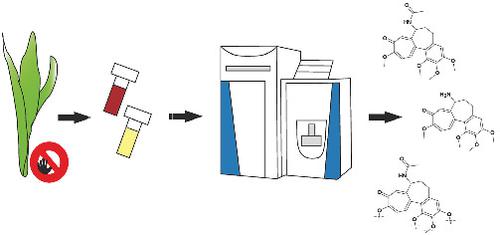当前位置:
X-MOL 学术
›
Drug Test. Anal.
›
论文详情
Our official English website, www.x-mol.net, welcomes your
feedback! (Note: you will need to create a separate account there.)
Toxic plants—Detection of colchicine in a fast systematic clinical toxicology screening using liquid chromatography–mass spectrometry
Drug Testing and Analysis ( IF 2.6 ) Pub Date : 2021-09-07 , DOI: 10.1002/dta.3160 Aline C Vollmer 1 , Lea Wagmann 1 , Markus R Meyer 1
Drug Testing and Analysis ( IF 2.6 ) Pub Date : 2021-09-07 , DOI: 10.1002/dta.3160 Aline C Vollmer 1 , Lea Wagmann 1 , Markus R Meyer 1
Affiliation

|
Colchicum autumnale, which can be mistaken for Allium ursinum, contains the alkaloid colchicine potentially leading to life-threatening up to fatal intoxications. We report two cases of acute intoxications with unexplained circumstances. Using the authors' systematic screening approaches, colchicine could be detected in blood plasma and urine samples using liquid chromatography coupled to linear ion trap mass spectrometry (LC-ITMSn) and high-resolution tandem mass spectrometry (LC-HRMS/MS). Metabolites of colchicine could be identified in urine for confirmation of screening results. Gas chromatography–mass spectrometry (GC-MS) analysis was also conducted, but colchicine could not be detected. Furthermore, colchicine concentration was estimated via LC-HRMS/MS in plasma samples. Results of the systematic screening indicated the ingestion of colchicine from both subjects. In both cases, the parent compound was detected in blood plasma and urine using the LC-HRMS/MS and LC-ITMSn system. An O-demethylation metabolite was identified in urine samples of both subjects using LC-HRMS/MS; the N-deacetylation product was also found in urine samples of both cases via LC-HRMS/MS and LC-ITMSn. The use of LC-ITMSn resulted only in the detection of the O-demethylation product in case 2. Plasma concentrations were estimated at 2.5 ng/ml and 4.7 ng/ml for cases 1 and 2, respectively. We demonstrated the detection of this highly toxic alkaloid in blood plasma and urine using a time-saving and reliable clinical systematic screening. Furthermore, we identified metabolites of colchicine being rarely discussed in literature, which can be used as additional screening targets.
中文翻译:

有毒植物——使用液相色谱-质谱法在快速系统的临床毒理学筛查中检测秋水仙碱
秋水仙,可能被误认为是葱属,含有生物碱秋水仙碱,可能导致危及生命甚至致命的中毒。我们报告了两起不明原因的急性中毒病例。使用作者的系统筛选方法,可以使用液相色谱与线性离子阱质谱联用(LC-ITMS n )检测血浆和尿液样品中的秋水仙碱) 和高分辨率串联质谱 (LC-HRMS/MS)。可以在尿液中鉴定秋水仙碱的代谢物,以确认筛查结果。还进行了气相色谱-质谱 (GC-MS) 分析,但未检测到秋水仙碱。此外,通过 LC-HRMS/MS 估计血浆样品中的秋水仙碱浓度。系统筛查的结果表明两个受试者都摄入了秋水仙碱。在这两种情况下,使用 LC-HRMS/MS 和 LC-ITMS n系统在血浆和尿液中检测到母体化合物。使用LC-HRMS/MS 在两名受试者的尿样中鉴定出O-去甲基化代谢物;通过 LC-HRMS/MS 和 LC-ITMS 在两个病例的尿液样本中也发现了N-脱乙酰化产物ñ。LC-ITMS n的使用仅导致在案例 2 中检测到O-去甲基化产物。对于案例 1 和 2,血浆浓度估计分别为 2.5 ng/ml 和 4.7 ng/ml。我们通过一种省时且可靠的临床系统筛查证明了在血浆和尿液中检测到这种剧毒生物碱。此外,我们确定了文献中很少讨论的秋水仙碱代谢物,可用作额外的筛选目标。
更新日期:2021-09-07
中文翻译:

有毒植物——使用液相色谱-质谱法在快速系统的临床毒理学筛查中检测秋水仙碱
秋水仙,可能被误认为是葱属,含有生物碱秋水仙碱,可能导致危及生命甚至致命的中毒。我们报告了两起不明原因的急性中毒病例。使用作者的系统筛选方法,可以使用液相色谱与线性离子阱质谱联用(LC-ITMS n )检测血浆和尿液样品中的秋水仙碱) 和高分辨率串联质谱 (LC-HRMS/MS)。可以在尿液中鉴定秋水仙碱的代谢物,以确认筛查结果。还进行了气相色谱-质谱 (GC-MS) 分析,但未检测到秋水仙碱。此外,通过 LC-HRMS/MS 估计血浆样品中的秋水仙碱浓度。系统筛查的结果表明两个受试者都摄入了秋水仙碱。在这两种情况下,使用 LC-HRMS/MS 和 LC-ITMS n系统在血浆和尿液中检测到母体化合物。使用LC-HRMS/MS 在两名受试者的尿样中鉴定出O-去甲基化代谢物;通过 LC-HRMS/MS 和 LC-ITMS 在两个病例的尿液样本中也发现了N-脱乙酰化产物ñ。LC-ITMS n的使用仅导致在案例 2 中检测到O-去甲基化产物。对于案例 1 和 2,血浆浓度估计分别为 2.5 ng/ml 和 4.7 ng/ml。我们通过一种省时且可靠的临床系统筛查证明了在血浆和尿液中检测到这种剧毒生物碱。此外,我们确定了文献中很少讨论的秋水仙碱代谢物,可用作额外的筛选目标。











































 京公网安备 11010802027423号
京公网安备 11010802027423号